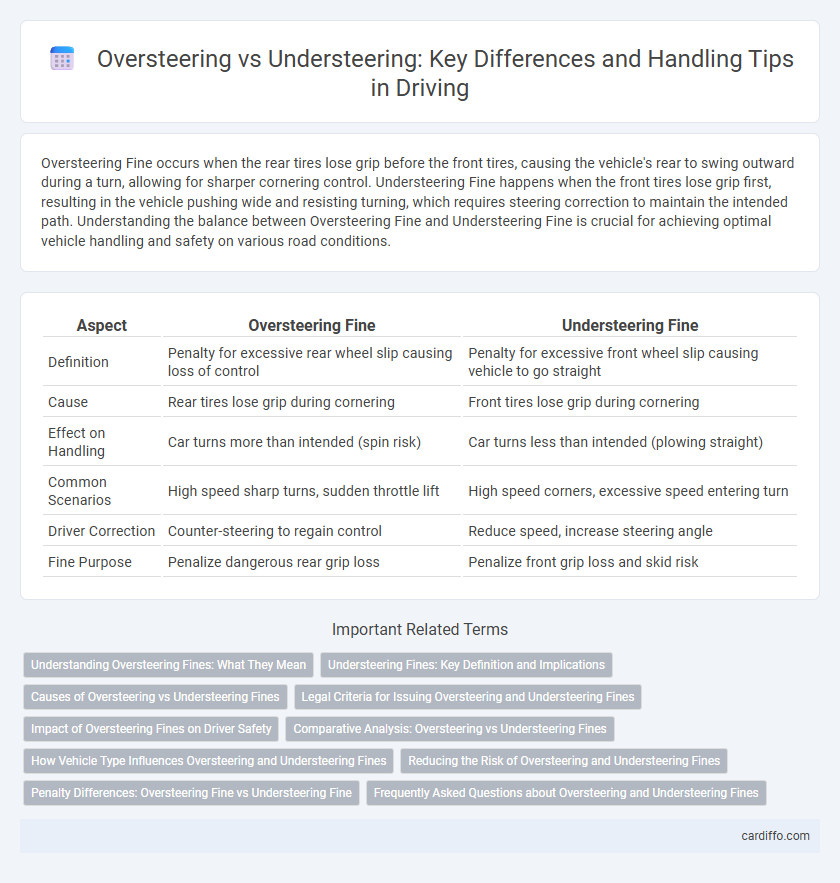Oversteering Fine occurs when the rear tires lose grip before the front tires, causing the vehicle's rear to swing outward during a turn, allowing for sharper cornering control. Understeering Fine happens when the front tires lose grip first, resulting in the vehicle pushing wide and resisting turning, which requires steering correction to maintain the intended path. Understanding the balance between Oversteering Fine and Understeering Fine is crucial for achieving optimal vehicle handling and safety on various road conditions.
Table of Comparison
| Aspect | Oversteering Fine | Understeering Fine |
|---|---|---|
| Definition | Penalty for excessive rear wheel slip causing loss of control | Penalty for excessive front wheel slip causing vehicle to go straight |
| Cause | Rear tires lose grip during cornering | Front tires lose grip during cornering |
| Effect on Handling | Car turns more than intended (spin risk) | Car turns less than intended (plowing straight) |
| Common Scenarios | High speed sharp turns, sudden throttle lift | High speed corners, excessive speed entering turn |
| Driver Correction | Counter-steering to regain control | Reduce speed, increase steering angle |
| Fine Purpose | Penalize dangerous rear grip loss | Penalize front grip loss and skid risk |
Understanding Oversteering Fines: What They Mean
Oversteering fines are penalties issued when a driver causes the rear wheels to lose traction and excessively slide during a turn, posing significant safety risks. These fines emphasize the importance of maintaining proper vehicle control to prevent loss of stability and potential accidents. Understanding oversteering fines helps drivers recognize the dangers of aggressive cornering and encourages safer driving behaviors.
Understeering Fines: Key Definition and Implications
Understeering fines occur when a vehicle's front tires lose grip, causing it to drift wide in a turn and fail to follow the intended path. These fines often result in legal penalties due to increased crash risks and impaired vehicle control. Understanding understeering fines emphasizes the importance of proper steering techniques and vehicle maintenance to ensure road safety and compliance with traffic laws.
Causes of Oversteering vs Understeering Fines
Oversteering fines typically result from aggressive steering inputs and excessive throttle application causing the rear tires to lose traction, which is often linked to high-speed cornering and rear-wheel drive vehicles. Understeering fines occur when the front tires lose grip, usually due to entering corners too fast, improper tire pressure, or insufficient steering angle, common in front-wheel drive cars. Both fines emphasize the importance of vehicle control and appropriate speed adjustment to prevent hazardous driving behaviors.
Legal Criteria for Issuing Oversteering and Understeering Fines
Legal criteria for issuing oversteering and understeering fines typically depend on the severity of control loss and resulting traffic hazards. Oversteering fines are imposed when a driver causes excessive vehicle rotation, leading to instability or potential accidents, as detected by law enforcement or through accident investigations. Understeering fines result from failure to maintain proper steering control, causing the vehicle to drift wide or collide with obstacles, with regulations often specifying speed limits, road conditions, and driver responsibility as key evaluation factors.
Impact of Oversteering Fines on Driver Safety
Oversteering fines directly address risky driving behaviors that lead to sudden loss of vehicle control, significantly increasing the likelihood of accidents. Enforcement of oversteering penalties promotes safer steering practices, reducing instances of spinouts and collisions on wet or slippery roads. Studies show that consistent oversteering fines enhance driver awareness and contribute to overall road safety by minimizing extreme handling errors.
Comparative Analysis: Oversteering vs Understeering Fines
Oversteering fines typically carry higher penalties compared to understeering fines due to the increased risk of loss of vehicle control and potential accidents. Law enforcement agencies impose stricter fines on oversteering because it often leads to more severe safety hazards, including spinouts and collisions. Understeering fines, while still enforced, generally result in lighter penalties as they usually involve less immediate danger and more manageable vehicle behavior.
How Vehicle Type Influences Oversteering and Understeering Fines
Oversteering fines and understeering fines vary significantly depending on the vehicle type, as heavier vehicles like trucks incur stricter penalties due to their increased risk of causing accidents. Passenger cars typically face moderate fines because they have greater maneuverability, which reduces the likelihood of severe incidents. Motorcycles, due to their high vulnerability during handling errors, often attract fines that emphasize rider safety and control violations.
Reducing the Risk of Oversteering and Understeering Fines
Reducing the risk of oversteering and understeering fines involves maintaining proper vehicle control and adhering to speed limits, especially on curves and turns where these issues commonly occur. Regular inspections and proper maintenance of tires, suspension, and steering systems can prevent handling errors that lead to oversteering or understeering. Drivers should also undergo defensive driving training focused on recognizing road conditions and adjusting driving techniques to avoid aggressive maneuvers that trigger such fines.
Penalty Differences: Oversteering Fine vs Understeering Fine
Oversteering fines typically carry higher penalties due to the increased risk of losing vehicle control and causing accidents, often resulting in steeper fines and points on the driver's license. Understeering fines, while serious, generally receive lower penalties as the vehicle tends to slide forward rather than spin, posing slightly less immediate danger. The distinct penalty differences reflect the varying degrees of risk and accident potential associated with oversteering versus understeering incidents.
Frequently Asked Questions about Oversteering and Understeering Fines
Oversteering fines typically penalize drivers for causing the rear wheels to lose traction, leading to loss of control, while understeering fines target situations where the vehicle fails to turn adequately, sliding forward instead. Common questions often address the legal speed limits triggering these fines, how different jurisdictions measure fault in oversteering versus understeering incidents, and the impact on insurance premiums. Drivers frequently inquire about ways to contest fines, the role of road conditions, and whether corrective driving courses can reduce penalties related to these specific driving behaviors.
Oversteering Fine vs Understeering Fine Infographic

 cardiffo.com
cardiffo.com